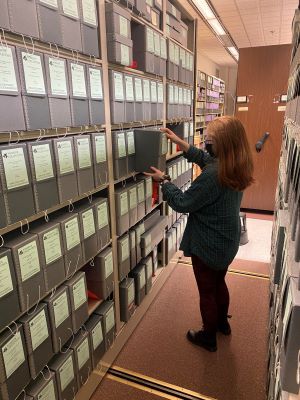Curating “Conceptions of Choice” Exhibit

As a gender and sexuality scholar, a self-described “feminist killjoy,” and a lifelong activist for social issues in Atlanta, I was honored to be selected as the Women’s Collections Graduate Assistant while completing my final year of graduate school— and even more excited to learn that the exhibit I’d be creating would allow me to tell the story of reproductive justice’s complicated history across the country.
My background in this field prepared me well for this project— I knew all the terminology, and most of the history— but I was surprised and a little overwhelmed by the depth of resources at my disposal. Sitting in the Archives Reading Room, sifting through piles upon piles of Ms. Magazine periodicals and protest pamphlets, I was struck with the recognition that I was not only telling the history of the abortion movement itself; I also had a unique chance to show the world how this issue has impacted real people— families, politicians, and communities at large— for generations to come, and what our future might look like without the protections of Roe v. Wade.
The landmark decision of Roe v. Wade in the winter of 1973 confirmed that a woman’s right to get an abortion was protected— but only 50 years later, that right has been stripped away, though May 2022 polls (only a month before the overturning of Roe) suggest that nearly 85% of Americans believe abortion is a human right. So how did we get here?
Well, it wasn’t as sudden of a change as many people might think; in fact, from the time Roe declared abortion a legally-protected right in 1973, countless pieces of legislation have sought to eliminate it— from restricting access to abortion clinics in rural areas, to banning American taxpayer funds from facilitating reproductive care, to even threatening new laws that prohibit access to some forms of birth control. In creating this exhibit, I learned about the tragedies and trauma that many healthcare providers, clinic volunteers, and desperate mothers endure in order to obtain reproductive procedures. I also learned about the ways in which religion, economics, and politics became the pillars of debate in this contentious issue.

My research for this exhibit offered me a first-hand look at the powerful people and movements that have fought both for and against reproductive rights in this country for more than half a century. With the overturning of Roe v. Wade in the summer of 2022, I am left with one question, and only time will reveal the answer: where do we go from here? As a scholar in this field, I’m committing to cataloging this complicated history and making sure that, if nothing else, the legacy of this fight will be remembered.